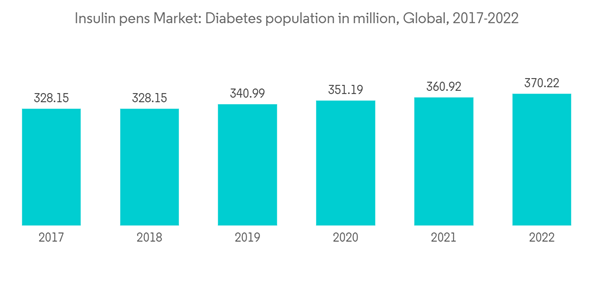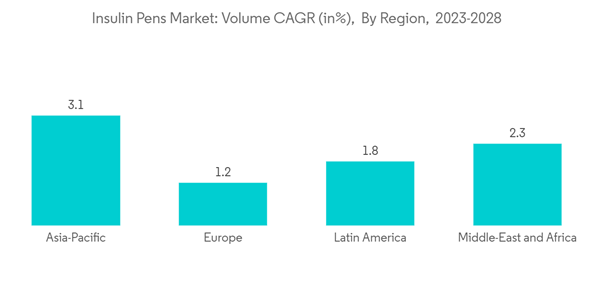Diabetes was one of the key comorbidities that were strongly linked to the risk of mortality and unfavorable clinical outcomes in people with COVID-19. People with diabetes were more vulnerable to COVID-19 infection than people without diabetes, and this vulnerability was greater in COVID-19 patients with a severe clinical course, according to numerous epidemiological studies. When diabetic patients or healthcare professionals were required to minimize contact and remain confined during the epidemic, telehealth provided an alternative form of support in averting acute complications and controlling extreme hyperglycemia. It was also recommended that diabetics not infected with the SARS-CoV-2 maintain optimum glycemic control to prevent COVID-19.
Diabetes is generally considered a lifestyle disease. Over time, incidences of the disease have increased with the population worldwide. A disposable insulin pen is a prefilled pen that should be thrown away after a single use. Reusable pens permit the insertion of a pen fill (cartridge), thus allowing repeated usage. The needles on a reusable pen should be replaced periodically. Insulin Pens (disposable and reusable) are the most widely used devices for administering insulin among diabetic patients, mostly in developed countries. The ease of use and accuracy in administration make insulin pen usage high among insulin users. Insulin has been used in treating diabetes for over 90 years globally. Even then, half of those who need insulin today still cannot afford and access it. People with Type 1 diabetes need insulin therapy, and the treatment focuses on managing blood sugar levels with insulin, diet, and lifestyle to prevent complications.
Insulin Pens Market Trends
The Market is Expected to Grow as the Number of Diabetes Patients Increase Year-On-Year
Blood glucose (or blood sugar) levels that are elevated in people with diabetes are chronic metabolic conditions that cause substantial harm to the heart, blood vessels, eyes, kidneys, and nerves over time. The most prevalent type of diabetes is type 2, which often affects adults and develops when the body stops producing enough insulin or becomes resistant to it. Type 2 diabetes has been much more common over the last three decades in nations of all income levels. Diabetes type 1 is a chronic illness in which the pancreas generates little or no insulin. It was previously referred to as juvenile diabetes or insulin-dependent diabetes. Access to affordable medical care, particularly insulin, is essential to the survival of people with diabetes. By 2025, the goal to stop the rise in diabetes and obesity has been universally agreed upon. The bulk of the approximately 422 million individuals with diabetes globally reside in low- and middle-income nations, and diabetes is directly responsible for 1.5 million fatalities annually. Throughout the past few decades, there has been a consistent rise in both the incidence and prevalence of diabetes. According to the most recent IDF Diabetes Atlas, the prevalence of diabetes has increased to 10.5% worldwide, with over half (44.7%) of individuals still undiagnosed. According to IDF predictions, 783 million adults, or one in eight individuals, are expected to have diabetes by 2045. This may represent a 46% rise, more than double the projected population growth for the same period (20%).At this time, type 1 diabetes cannot be prevented. Effective methods for preventing type 2 diabetes, as well as the complications and early death that can arise from all types of diabetes are available. These include laws and procedures that apply to entire populations as well as to particular environments (such as a school, home, or workplace) and that promote good health for everyone, regardless of whether they have diabetes, such as regular exercise, a healthy diet, quitting smoking, and maintaining healthy blood pressure and lipid levels. Early diagnosis is essential to living well with diabetes; the longer a person goes without diagnosis and treatment, the more adversely their health outcomes are expected to develop. As a result, primary healthcare facilities should provide simple access to fundamental diagnostics like blood glucose testing. Patients will require routine expert evaluation or treatment for problems.
Asia-Pacific Holds Highest Market Share
Asian nations have witnessed a sharp rise in the number of people with diabetes over the past few decades, particularly those with type 2. More than 70% of people with diabetes live in developing nations. The Asia-Pacific region is expected to witness significant growth as a result of an aging population and an increase in diabetes prevalence, which is mainly caused by increased stress levels, sedentary lifestyles, smoking, and excessive alcohol use that raises blood sugar levels. Also, the production infrastructure of some anti-diabetic medicine manufacturers in the area contributed to the market expansion. However, one of the leading commercial restraints is thought to be the rising cost of pharmaceuticals. Some 227 million individuals in the Asia-Pacific region have type 2 diabetes, and about half of them are misdiagnosed and uninformed that they will experience long-term consequences, according to the OECD iLibrary. Also, according to data from the World Diabetes Federation, the number of adults in Southeast Asia (SEA) who have diabetes is expected to rise from 90 million in 2021 to 113 million in 2030 and 152 million in 2045.According to Volza's 2023 statistics on Japan exports, two insulin pen shipments from Japan were sent by one Japanese exporter to one buyer. Most of Japan's insulin pens are exported to Vietnam and India. In recent years, diabetes prevalence has alarmingly increased in the Asia-Pacific region. Diabetes is becoming more prevalent than ever in developing nations like China and India. People with diabetes must make several adjustments during the day to keep their blood glucose levels within acceptable ranges. Examples include taking oral anti-diabetic medicine or consuming more carbs while monitoring their blood glucose levels. Leading manufacturers are concentrating on technological advancements and creating cutting-edge items to capture a sizeable portion of the market.
It is, therefore, anticipated to drive the category expansion during the forecast period due to the factors mentioned above.
Insulin Pens Industry Overview
The insulin pens market is consolidated, with three significant manufacturers holding the global market presence and the remaining manufacturers confined to the other local or region-specific manufacturers. Mergers and acquisitions or other partnerships within the insulin pens market are limited, as every company manufactures its insulin pens to be compatible with its portfolio of medications.Additional Benefits:
- The market estimate (ME) sheet in Excel format
- 3 months of analyst support
This product will be delivered within 2 business days.
Table of Contents
Companies Mentioned (Partial List)
A selection of companies mentioned in this report includes, but is not limited to:
- Novo Nordisk
- Sanofi
- Eli Lilly
- Biocon
- Julphar










